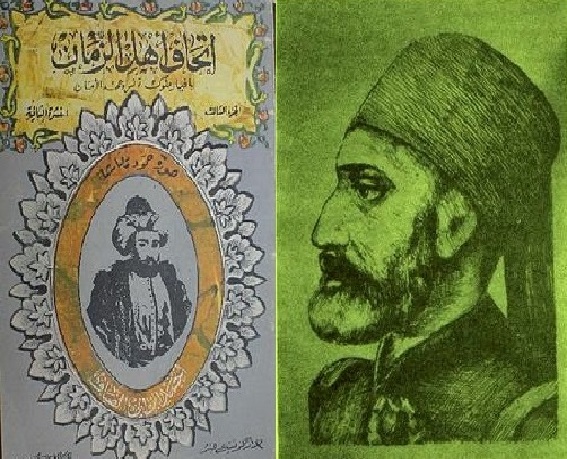Ithaf Ahl al-zaman bi Akhbar muluk Tunis wa ‘Ahd el-Aman (translated as Presenting Contemporaries the History of Rulers of Tunis and the Fundamental Pact)
The book is known for its acronym Al-Ithahaf, which is written by the Tunisian historian Ibn Abi Al-Diaf, who lived in the nineteenth century AD. In it, he dealt with the history of Tunisia from the Arab-Islamic invasion to the era of the writer, with a focus on the Ottoman era in Tunisia, especially the periods of the rule of the Husseinite Beys. The book is considered one of the most important sources for the modern history of Tunisia.
The book originally contains four volumes, and is arranged in an introduction, eight chapters, and a conclusion. However, it was issued in 8 parts, distributed as follows:
The introduction includes the first and second parts:
The first part is a theoretical introduction to the book based on the analysis of the author’s reformist theories and his call for restricting absolute rule in Tunisia with Sharia law.
He also praised the organizations, indicating their usefulness in an attempt to convince the necessity of implementing reforms and putting an end to the absolute rule and the injustice of the Beys and the arbitrariness of their workers through arguments.
The second part is a summary of the history of Tunisia from the Arab-Islamic conquest to the period before Hamouda Pasha al-Husayni, relying on previous sources.
The third part contains five chapters, each of which relates to one of the beys: Hamouda Pasha, Othman Bey, Mahmoud Bey, Hussein Pasha Bey, Mustafa Bey.
Ibn Abi al-Diyaf learned about the reign of Hamouda Pasha from his father, Al-haj (the pilgrim) Bidief, who served this bey. He relied on other eyewitnesses such as Sheikhs Ismail Al-Tamimi and Ahmed Al-Abi, in addition to his reliance on original documents, then Ibn Abi Al-Diaf was himself an eyewitness to the times of several beys by virtue of his work with them. He also talked about the occupation of Algeria in 1830 and the echoes of that in Tunisia.
The fourth part is about the eras of the Marshals Ahmed Pasha Bey and Muhammad Pasha Bey, in which the author, in relation to the era of the first of them, exposed the following issues: the increase of soldiers, the establishment of the Military School in Bardo, the establishment of the Ahmadiyya Library, the arrangement of teaching at the Zaytuna Mosque, the freeing of the Mamluks, the trip to France, Military aid to the Ottoman Empire.
As for the reign of the second Field Marshal Muhammad Pasha Bey, in this part Ibn Abi Al-Diaf spoke about the organization of the Sharia courts, the Agriculture Circular, the devaluation of the military, etc.
The fifth part was devoted by Ibn Abi Al-Diaf to the first part of the reign of Muhammad Al-Sadiq Pasha Bey, in which he talked about the following issues: taking the oath to respect the Pact of safety, the establishment of the telegraph in Tunisia, the establishment of the printing press and the newspaper Al-Raed Al-Tunisi, the formation of the councils emanating from the Pact of Safety, the meeting of the Bey with Napoleon in Algeria, the problem of foreign privileges, stopping the work of the Pact of Safety, fueled by the revolution of Ali bin Ghadhahm in 1864.
Part VI: It is a continuation of the reign of Muhammad al-Sadiq Bey up to the year 1872, that is, two years before the death of Ibn Abi Al-Diaf, while the reign of Muhammad al-Sadiq Pasha Bey extended after that to the year 1882.
The conclusion includes the seventh and eighth parts: it includes 407 translations of Tunisian personalities who died between the reign of Hammouda Pasha and the year 1872. The author was not limited to judges, scholars, and statesmen, but also concerned himself with the notables of the city of Tunis and some major cities and tribal chiefs. Supplements containing 25 letters written by Ibn Abi Al-Diaf were added to the eighth part of the 1990 edition.











